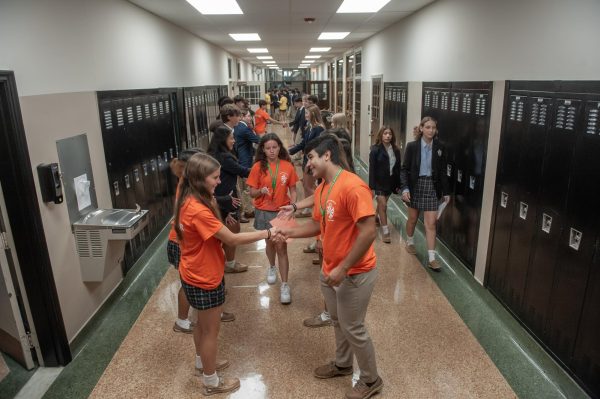COVID Reshapes Classroom Learning
This school year has undoubtedly been a challenge for all. Teachers, e-learners and hybrid students alike were forced to adapt and find new ways of learning amidst times of uncertainty. Yet with more and more people receiving vaccinations across the country, the promise of a more normal learning experience seems likely in the coming year. However, as this unique school year draws to a close, many teachers and students are left wondering how COVID will forever reshape teaching and learning in the future.
Theology teacher Mr. Slajchert taught exclusively online and just recently came back to teach in-person. When asked what he has learned throughout this strange pandemic school year, Mr. Slajchert jokes, “ I’ve learned a lot this year! Like how to keep my cat from jumping onto my laptop during Zoom classes, and how happy I would be if I never did a Zoom conference for the rest of my life! I have been teaching remotely all year long until I returned after Easter break—thirteen months since I had been in a classroom. I have learned that teaching in my pajamas is not a good trade-off for being in a classroom with other human beings. I have missed that energy, the back and forth, the shared experiences.” This heightened appreciation for learning as a community is a sentiment shared by French and German teacher Ms. Heinz, who also spent most of this school year teaching remotely and recently returned to in-person teaching this April. Explaining one of her biggest takeaways from remote instruction, Ms. Heinz stated, “The importance of human connection. Seeing my students in-person is so much more meaningful.”
Like teachers, students are also realizing that while COVID might not be as present in the future, it will leave a lasting impact on school and learning systems. Students are anticipating that many of these permanent changes will come as a result of teachers learning new ways to teach during COVID. Maribel Morales, a junior at Fenwick, stated, “There won’t be any snow days or excuses for late assignments because there are more apps now like Zoom that help students have lessons at home if you can’t make it to school.” In regards to these changing expectations and how e-learning in the future, Ms. Heinz states, “I think that eLearning will always be with us in some form or another. Between variants, vaccine refusal, and the fact that some people prefer it because of learning styles and flex time for work/school/home, I think remote learning will be incorporated with face to face instruction in some manner in the future.”
In addition to this, many students feel that after this school year, teachers will utilize technology even more as they teach. Commenting on this, Maribel states, “Most teachers now know how to use the internet well because of the required classes they had to take. This helped them learn about how the internet system works… now they know what we know.” Echoing these sentiments, Ms. Heinz reflects, “Before the pandemic I didn’t use technology much in the classroom. Now, however, I use it most of the time and plan to keep doing so. Being forced to use technology was difficult, but a blessing as it forced creativity and mastery of an important tool.”
Moving into a new school year, it is unclear exactly what long term impacts COVID will have on the learning environment. What is clear, however, is that by working in a collaborative and supportive environment, Fenwick students and teachers will continue to adapt and grow as they have this past year. As Mr. Slajchert affirms, “I have learned how important it is for all of us to look after and care for all of us; that there is no challenge that is so monumental that people working together, respecting each other, and treating each other as God’s children cannot overcome. All the tech in the world is secondary to that.”




